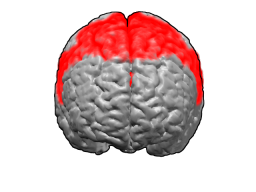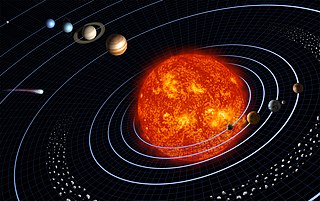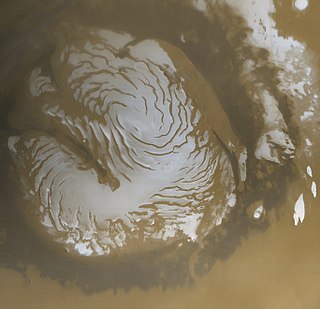
A glacier is a persistent body of dense ice that is constantly moving under its own weight. A glacier forms where the accumulation of snow exceeds its ablation over many years, often centuries. It acquires distinguishing features, such as crevasses and seracs, as it slowly flows and deforms under stresses induced by its weight. As it moves, it abrades rock and debris from its substrate to create landforms such as cirques, moraines, or fjords. Although a glacier may flow into a body of water, it forms only on land and is distinct from the much thinner sea ice and lake ice that form on the surface of bodies of water.

The cryosphere is an all-encompassing term for the portions of Earth's surface where water is in solid form, including sea ice, lake ice, river ice, snow cover, glaciers, ice caps, ice sheets, and frozen ground. Thus, there is a wide overlap with the hydrosphere. The cryosphere is an integral part of the global climate system. It also has important feedbacks on the climate system. These feedbacks come from the cryosphere's influence on surface energy and moisture fluxes, clouds, the water cycle, atmospheric and oceanic circulation.

Brodmann area 6 (BA6) is part of the frontal cortex in the human brain. Situated just anterior to the primary motor cortex (BA4), it is composed of the premotor cortex and, medially, the supplementary motor area (SMA). This large area of the frontal cortex is believed to play a role in planning complex, coordinated movements.

The Queen Elizabeth Islands are the northernmost cluster of islands in Canada's Arctic Archipelago, split between Nunavut and the Northwest Territories in Northern Canada. The Queen Elizabeth Islands contain approximately 14% of the global glacier and ice cap area. The southern islands are called the Parry Islands or Parry Archipelago.

A polar ice cap or polar cap is a high-latitude region of a planet, dwarf planet, or natural satellite that is covered in ice.

Rockne Lee Brubaker, II is an American former competitive pair skater. With Keauna McLaughlin, he is the 2010 Four Continents silver medalist, the 2007 World Junior champion, and a two-time (2008–2009) U.S. national champion. With Mary Beth Marley, he is the 2012 Four Continents bronze medalist and 2012 U.S. silver medalist.

The 2001 IIHF World U20 Championship, commonly referred to as the 2001 World Junior Hockey Championships, was the 25th edition of the Ice Hockey World Junior Championship. The tournament was held in Moscow and Podolsk, Russia from December 26, 2000 to January 5, 2001. The Czech Republic won the gold medal for the second consecutive year with a 2–1 victory over Finland in the championship game, while Canada won the bronze medal with a 2–1 overtime victory over Sweden.

The 2000 World Junior Hockey Championships, was the 24th edition of the Ice Hockey World Junior Championship. The tournament was hosted in Skellefteå and Umeå, Sweden from December 25, 1999, to January 4, 2000. The Czech Republic won the gold medal with a 1–0 shootout victory over Russia in the championship game, while Canada won the bronze medal with a 4–3 shootout victory over the United States. This still remains as the only tournament to where both medal games have been decided in a shootout.

The study of extraterrestrial atmospheres is an active field of research, both as an aspect of astronomy and to gain insight into Earth's atmosphere. In addition to Earth, many of the other astronomical objects in the Solar System have atmospheres. These include all the gas giants, as well as Mars, Venus and Titan. Several moons and other bodies also have atmospheres, as do comets and the Sun. There is evidence that extrasolar planets can have an atmosphere. Comparisons of these atmospheres to one another and to Earth's atmosphere broaden our basic understanding of atmospheric processes such as the greenhouse effect, aerosol and cloud physics, and atmospheric chemistry and dynamics.

Robert A. Bindschadler is a senior fellow at NASA's Goddard Space Flight Center and has been an active field researcher in the Antarctic for over 25 years. He is a past president of the International Glaciological Society, chairs the West Antarctic Ice Sheet Initiative, is an editor for the Journal of Glaciology and has led 14 expeditions to Antarctica and has participated in numerous other expeditions around the world including Greenland. He has also testified before Congress and has briefed the U.S. vice president concerning ice-sheet stability and is often quoted or featured in the media. He was born in Pittsburgh and received a B.S. in astronomy and physics in 1971 from the University of Michigan and earned his PhD in geophysics from the University of Washington in 1978 and did postdoctoral work in Switzerland prior to working at NASA.

Dye 3 is an ice core site and previously part of the DYE section of the Distant Early Warning (DEW) line, located at in Greenland. As a DEW line base, it was disbanded in years 1990/1991.

The 1999 World Junior Ice Hockey Championships was held in Winnipeg, and five other communities in Manitoba, Canada from December 26, 1998, to January 5, 1999. In the gold medal match at Winnipeg Arena, Russia defeated Canada 3–2 on Artem Chubarov's overtime goal. The bronze medal was claimed by Slovakia, giving the six-year-old country its first medal at an IIHF event.

The Lunar Reconnaissance Orbiter (LRO) is a NASA robotic spacecraft currently orbiting the Moon in an eccentric polar mapping orbit. Data collected by LRO have been described as essential for planning NASA's future human and robotic missions to the Moon. Its detailed mapping program is identifying safe landing sites, locating potential resources on the Moon, characterizing the radiation environment, and demonstrating new technologies.

The Mare Australe quadrangle is one of a series of 30 quadrangle maps of Mars used by the United States Geological Survey (USGS) Astrogeology Research Program. The Mare Australe quadrangle is also referred to as MC-30. The quadrangle covers all the area of Mars south of 65°, including the South polar ice cap, and its surrounding area. The quadrangle's name derives from an older name for a feature that is now called Planum Australe, a large plain surrounding the polar cap. The Mars polar lander crash landed in this region.

Eric J. Rignot is the Donald Bren, Distinguished and Chancellor Professor of Earth system science at the University of California, Irvine, and a Senior Research Scientist for the Radar Science and Engineering Section at NASA's Jet Propulsion Laboratory. He studies the interaction of the polar ice sheets in Greenland and Antarctica with global climate using a combination of satellite remote sensing, airborne remote sensing, understanding of physical processes controlling glacier flow and ice melt in the ocean, field methods, and climate modeling. He was elected at the National_Academy_of_Sciences in 2018.
2005 in Iraq was marked by the first elections held in the country since the fall of Saddam Hussein.

The planet Mars has two permanent polar ice caps. During a pole's winter, it lies in continuous darkness, chilling the surface and causing the deposition of 25–30% of the atmosphere into slabs of CO2 ice (dry ice). When the poles are again exposed to sunlight, the frozen CO2 sublimes. These seasonal actions transport large amounts of dust and water vapor, giving rise to Earth-like frost and large cirrus clouds.

A lunar rover or Moon rover is a space exploration vehicle designed to move across the surface of the Moon. The Apollo program's Lunar Roving Vehicle was driven on the Moon by members of three American crews, Apollo 15, 16, and 17. Other rovers have been partially or fully autonomous robots, such as the Soviet Union's Lunokhods, Chinese Yutus, Indian Pragyan, and Japan's LEVs. Five countries have had operating rovers on the Moon: the Soviet Union, the United States, China, India, and Japan.
IdleAir, a division of Convoy Solutions LLC, is a company that provides in-cab services to truckers via centralized systems at truck stops around the United States. IdleAir's service, the patented Advanced Travel Center electrification (ATE), was more complex and more expensive than traditional truck stop electrification (TSE) systems which are aimed at idle reduction reducing the amount of fuel consumed by trucks while they idle during rests.

Operation IceBridge (OIB) was a NASA mission to monitor changes in polar ice. It is an airborne follow-on mission to the ICESat satellite, until after the ICESat-2 mission was launched in September 2018. OIB ended in 2019.

















